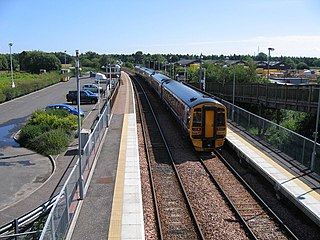Cupar is a town, former royal burgh and parish in Fife, Scotland. It lies between Dundee and Glenrothes. According to a 2011 population estimate, Cupar had a population around 9,000, making it the ninth-largest settlement in Fife, and the civil parish a population of 11,183. It is the historic county town of Fife, although the council now sits at Glenrothes.

Cowdenbeath is a town and burgh in west Fife, Scotland. It is 5 miles (8 km) north-east of Dunfermline and 18 miles (29 km) north of the capital, Edinburgh. The town grew up around the extensive coalfields of the area and became a police burgh in 1890. According to a 2008 estimate, the town has a population of 14,081.

The Fife Circle is the local rail service north from Edinburgh. It links towns of south Fife and the coastal towns along the Firth of Forth before heading to Edinburgh. Operationally, the service is not strictly a circle route, but, rather, a point to point service that reverses at the Edinburgh end, and has a large bi-directional balloon loop at the Fife end.

Aberdour railway station is a railway station in the village of Aberdour, Fife, Scotland. The station is managed by ScotRail and is on the Fife Circle Line.

Burntisland railway station is a railway station in the town of Burntisland, Fife, Scotland. The station is managed by ScotRail and is on the Fife Circle Line.

Glenrothes with Thornton railway station serves the communities of Glenrothes and Thornton in Fife, Scotland. The station is managed by ScotRail and is on the Fife Circle Line, 31+1⁄4 miles (50.3 km) north of Edinburgh Waverley.

Cardenden railway station is a railway station in Cardenden, Fife, Scotland. The station is managed by ScotRail and is on the Fife Circle Line, 27 miles (43 km) north of Edinburgh Waverley. It opened to traffic in 1848, on the Dunfermline Branch of the Edinburgh and Northern Railway.

Cowdenbeath railway station is a railway station in the town of Cowdenbeath, Fife, Scotland. The station is managed by ScotRail and is on the Fife Circle Line, 22+1⁄2 miles (36.2 km) north of Edinburgh Waverley.

Dunfermline Queen Margaret railway station is a railway station in the town of Dunfermline, Fife, Scotland. The station is managed by ScotRail and is on the Fife Circle Line, 18+1⁄2 miles (29.8 km) north of Edinburgh Waverley. The station takes its name from the nearby Queen Margaret Hospital. It is the longest railway station name in Scotland.

The Stirling and Dunfermline Railway was a railway in Scotland connecting Stirling and Dunfermline. It was planned by the Edinburgh and Glasgow Railway to get access to the mineral deposits on the line of route, but also as a tactical measure to keep the rival Caledonian Railway out of Fife.
The Edinburgh and Northern Railway was a railway company authorised in 1845 to connect Edinburgh to both Perth and Dundee. It relied on ferry crossings of the Firth of Forth and the Firth of Tay, but despite those disadvantages it proved extremely successful. It took over a short railway on the southern shore of the Forth giving a direct connection to Edinburgh, and it changed its name to the Edinburgh, Perth and Dundee Railway.
The St Andrews Railway was an independent railway company, founded in 1851 to build a railway branch line from the university town of St Andrews, in Fife, Scotland, to the nearby main line railway. It opened in 1852. When the Tay Rail Bridge opened in 1878 residential travel to Dundee was encouraged.
The Newport Railway was a Scottish railway company, that built a line along the south bank of the Firth of Tay in Fife. The line was opened in 1879, and connected to the Tay Bridge, giving quick access to Dundee; daily residential travel to Dundee from Tayport became a practicality.
The Wemyss and Buckhaven Railway was a railway company that built a line in the county of Fife in Scotland, connecting Buckhaven with the main line railway network at Thornton, and linking with collieries.
Several mineral railways were constructed around Dunfermline in western Fife, Scotland, in the eighteenth century and later. Their purpose was to convey minerals to market from the outcropping coal deposits that had encouraged industrial activity in the area from an early date.

Tayport railway station served the town of Tayport, Fife, Scotland from 1848 to 1967 on the Newport Railway.
Glenburnie railway station was a temporary terminus that served the area of Glenburnie, Fife, Scotland from 1847 to 1848 on the Edinburgh and Northern Railway and the Newburgh and North Fife Railway.
Dairsie railway station served the village of Dairsie, Fife, Scotland from 1848 to 1954 on the Edinburgh and Northern Railway.
Leuchars (Old) railway station served the town of Leuchars, Fife, Scotland from 1848 to 1967 on the Edinburgh and Northern Railway.

Cowdenbeath railway station served the town of Cowdenbeath, Fife, Scotland, from 1848 to 1919 on the Edinburgh and Northern Railway.











